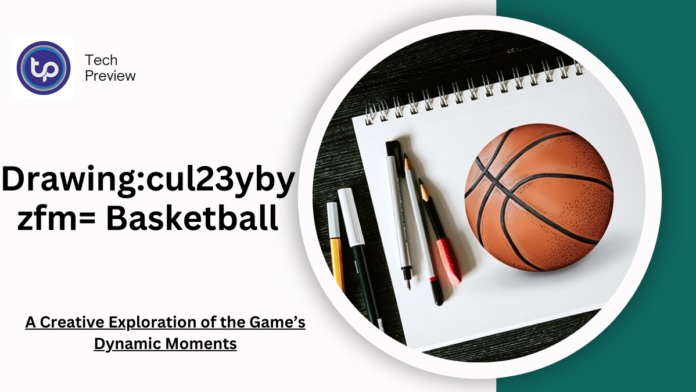For basketball enthusiasts, the thrill of the game can extend far beyond the court. If you have a passion for art and a love for basketball, merging these interests can lead to a fulfilling creative journey.
Drawing basketball not only allows you to capture the energy and excitement of the sport but also enables you to express your unique perspective.
In this comprehensive guide, we’ll explore Drawing:cul23ybyzfm= Basketball, essential materials and fundamental techniques to advanced methods for creating stunning basketball artwork.
Drawing:cul23ybyzfm= Basketball?
Art serves as a powerful medium to celebrate what you love. When you draw basketball, you can immortalize iconic moments, depict your favourite players, or recreate the atmosphere of an intense game.
This celebration can manifest in various ways, whether through a detailed portrayal of a slam dunk or an abstract representation of the emotions felt during a critical moment in a game.
MUST READ:Sketch:jgr9lxsmgmg= Art ideas: The Power of Sketch Art Ideas
Enhancing Your Artistic Skills
Engaging with basketball art is an excellent way to enhance your drawing skills. The sport’s fast-paced nature provides unique challenges, such as capturing motion, understanding proportions, and conveying emotion.
These elements make basketball an ideal subject for honing your artistic abilities, allowing you to improve in areas like anatomy, perspective, and shading.
Each artist brings a unique style and viewpoint to their work. Drawing basketball offers a canvas to express your personal connection to the sport.
You can explore various themes—like teamwork, competition, or perseverance—through your illustrations, allowing you to communicate your feelings and ideas about basketball visually.
Sharing your artwork can connect you with fellow basketball fans and artists. Engaging with a community of like-minded individuals can lead to valuable feedback, inspiration, and even collaboration.
Whether through social media, local art shows, or basketball-related events, showcasing your art can deepen your connection to the sport and the people who love it.
Essential Materials for Drawing:cul23ybyzfm= Basketball
Before you start sketching, it’s essential to gather the right materials. Here’s a comprehensive list to help you set up your workspace:
Quality Drawing Paper
Choose high-quality drawing paper that can handle various mediums. If you plan to use pencils, a textured sketchbook is ideal for detailed work. For ink or markers, smooth paper will allow for cleaner lines.
A Range of Pencils
Having a selection of pencils is crucial. Soft pencils (B grades) are excellent for shading, while harder pencils (H grades) are perfect for fine details. An HB pencil serves as a good all-purpose option for initial sketches.
Erasers
Utilize both kneaded and vinyl erasers. A kneaded eraser is versatile for gently lifting graphite and creating highlights, while a vinyl eraser is effective for broader corrections.
Reference Images
Collect a library of reference images, including photographs of basketball players in action, court layouts, and moments from famous games. These references will help you capture realistic details in your artwork.
Inking Pens and Markers
Fine-tip pens and markers are essential for inking your sketches. They can add depth, contrast, and texture, making your drawings pop. Consider using a variety of nib sizes for different line weights.
Ruler and Straightedge
A ruler or straightedge is helpful for ensuring accuracy in your drawings, especially when depicting the basketball court and player positioning. This tool will help you maintain correct proportions throughout your artwork.
Optional Tools
- Colored Pencils or Markers: If you want to incorporate color into your drawings, high-quality colored pencils or markers can enhance your artwork significantly.
- Blending Tools: Stumps or blending brushes can be useful for softening pencil lines and creating smoother transitions in shading.
Fundamental Techniques for Drawing Basketball
With the right materials in hand, you can start developing your basketball art skills. Here are some fundamental techniques to keep in mind:
Start with Basic Shapes
Begin your drawing process by establishing the basic forms of the players and the court. Use simple geometric shapes—circles for heads, ovals for limbs, and rectangles for the torso. This foundational approach will help you accurately position elements before adding details.
Capture Movement and Energy
Basketball is a sport defined by its speed and dynamism. To convey movement effectively, employ action lines and fluid poses. Study the biomechanics of different basketball moves, such as dribbling, shooting, and defending, to understand how to represent these actions on paper.
Proportions Matter
Maintaining accurate proportions is crucial for realistic drawings. Use reference images to compare the sizes of various elements, such as the player’s height relative to the basketball and the dimensions of the court. Measuring with your pencil can help ensure that your proportions remain consistent throughout your artwork.
Add Detail Gradually
Once you have established the basic shapes, start adding details. Focus on facial expressions, the texture of clothing, and specific markings on the basketball court. Details like sweat, motion blur, or the intensity in a player’s eyes can add life and emotion to your drawing.
Shading and Highlighting
Incorporate shading to create depth and dimensionality. Pay close attention to light sources and how they affect shadows on players and the court. Use varying pencil pressures to achieve a range of tones and create highlights that give your drawing a three-dimensional quality.
Advanced Techniques for Enhancing Your Drawing:cul23ybyzfm= Basketball
Different perspectives can significantly enhance the visual impact of your drawings. A low-angle view can make a player appear more imposing during a dunk, while a bird’s-eye view can provide an interesting take on the layout of the court.
Experimenting with angles adds depth and can make your artwork more engaging.
If you choose to incorporate colour, think carefully about its placement.
Use vibrant colours to highlight key elements, such as team uniforms or the basketball itself. Consider the emotional impact of colour—warm tones can evoke excitement, while cooler tones might convey calmness.
Adding backgrounds can enhance the overall composition of your basketball drawings. Illustrate elements such as the cheering crowd, the scoreboard, or even the arena’s architecture to provide context and enrich the narrative of your piece.
The key to improvement in any art form is practice. Set aside time each week to draw, and don’t hesitate to explore different styles, techniques, or mediums.
Challenge yourself with new subjects within basketball, such as training scenes or candid moments off the court.
Conclusion
Drawing:cul23ybyzfm= Basketball is a rewarding artistic pursuit that allows you to celebrate your passion for the sport while honing your creative skills. With the right materials, techniques, and dedication, you can create stunning artwork that captures the spirit of basketball.
Whether you aim to depict the thrill of a championship game or the beauty of a well-executed play, your drawings can serve as a unique expression of your love for the game.
People May Ask
1. What materials are essential for drawing basketball?
You will need quality drawing paper, a variety of pencils, erasers, reference images, inking pens, a ruler, and optionally colored pencils or blending tools.
2. How can I improve my drawing skills over time?
Regular practice, studying anatomical references, and experimenting with different techniques and styles will help you enhance your artistic abilities.
3. What are some effective angles for drawing basketball scenes?
Consider using low-angle perspectives for dramatic action and aerial views for a strategic look at player formations and movements.
4. Should I use colour in my basketball drawings?
Using colour can add vibrancy and emotional depth to your artwork. Be strategic about its application to highlight key elements.
5. Where can I find inspiration for my basketball drawings?
Look for inspiration in memorable games, personal experiences, athlete biographies, or through social media platforms that showcase sports art. Engaging with basketball culture can also provide fresh ideas.
Click here to learn more.









